The Silo Paintings
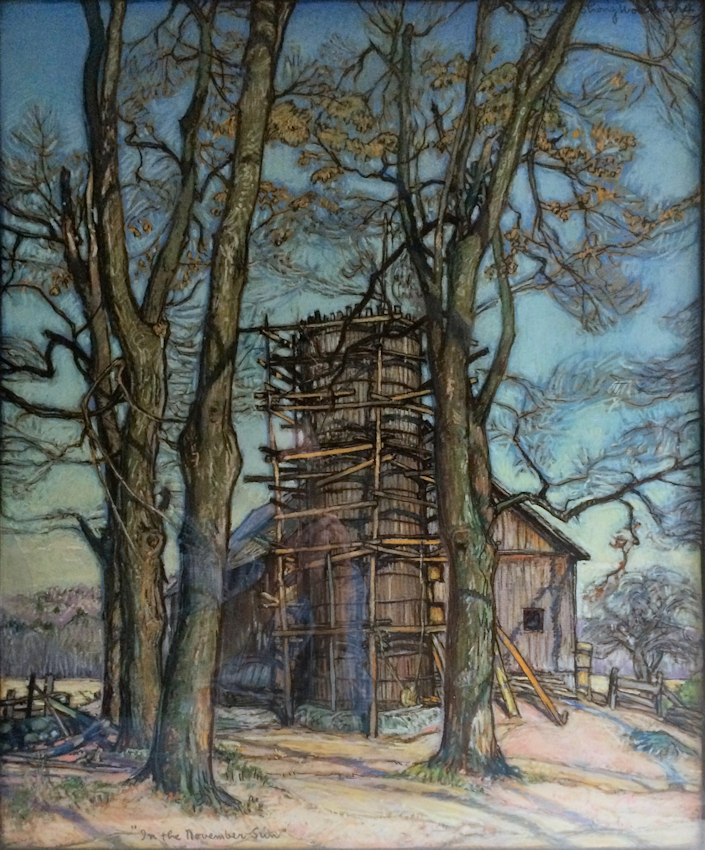
 In the November Sun, chalk, 1929
In the November Sun, chalk, 1929
This pastel painting premiered with its sibling
New Silo at the '29 Myles Standish Gallery
and without the oil at the '32 Deerfield Academy.
In the 1920's Robert Strong Woodward made three pictures of a silo in the process of being built, one a chalk drawing, which he
titled The Unfinished Silo, and the second, an oil titled The New Silo. This oil was later copied as a chalk drawing and titled In the November Sun.
Read his description below:
Woodward's Painting Diary Comments:
"Painted prior to 1930. All said
about the picture in my diary (Across the Valley) applies exactly to
this one also; in the same way it is the property of John W. Haigis. A painting of a silo with scaffolding over at the Kendrick farm and back road
from Ashfield to Conway (Archibald MacLeish road). Also, made a chalk drawing of the same subject."
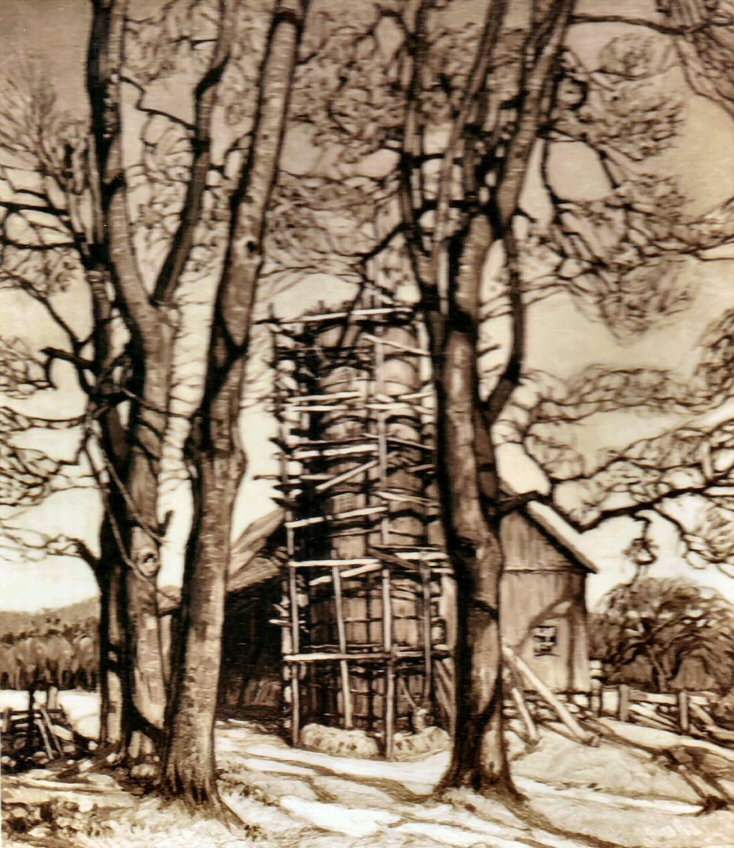
 New Silo, oil, 1929
New Silo, oil, 1929
This pastel painting premiered with its sibling, In
the November Sun, at the '29 Myles Standish Gal-
lery, and again in '44 without the chalk drawing.
In the past few weeks my wife and I have traversed all of the old roads between Conway and Ashfield looking for, hopefully, the old barn behind the
silo. We well knew that the silo would be long gone along with all of the other unused silos in our country area. We never found such a barn either.
Then last night I called an old former patient of mine who lived in that area all of his life, John Krasnoselsky. John is now 95 and beset with multiple
maladies. He told me that his doctor is talking "days or weeks" not "months" these days. I questioned John as to whether he remembered a Kendrick
farm which would fit the description above. He did. "It is a yellowish painted house at the bottom of the hill just past the Beldingville Cemetery on
Beldingville Road in South Ashfield. The barn fell down years ago but the house is being restored by a New York City architect."
So today we went back to the Beldingville area of Ashfield and found the house. No one was home but we walked up and down the road in front of the house and discovered nearby the old foundation of the silo and a stonewall foundation of a part of the old barn. Both of these show in the painting. One of the current photos looks down into the cistern which is about 6 feet deep. Please examine the photos of the area taken today and compare them with the painting and the chalk drawing done 75 some years ago.
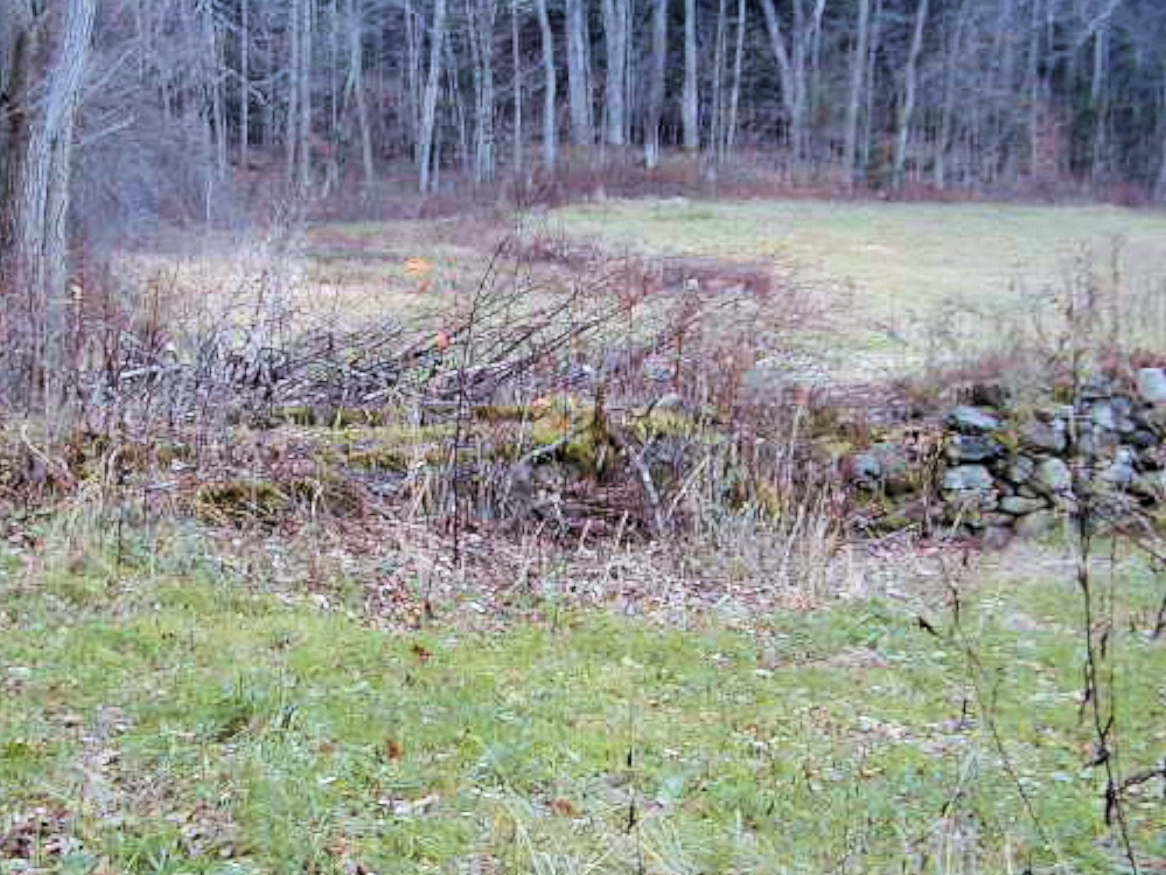
 Moss covered cistern on the left, stone wall barn foundation on the right
Moss covered cistern on the left, stone wall barn foundation on the right
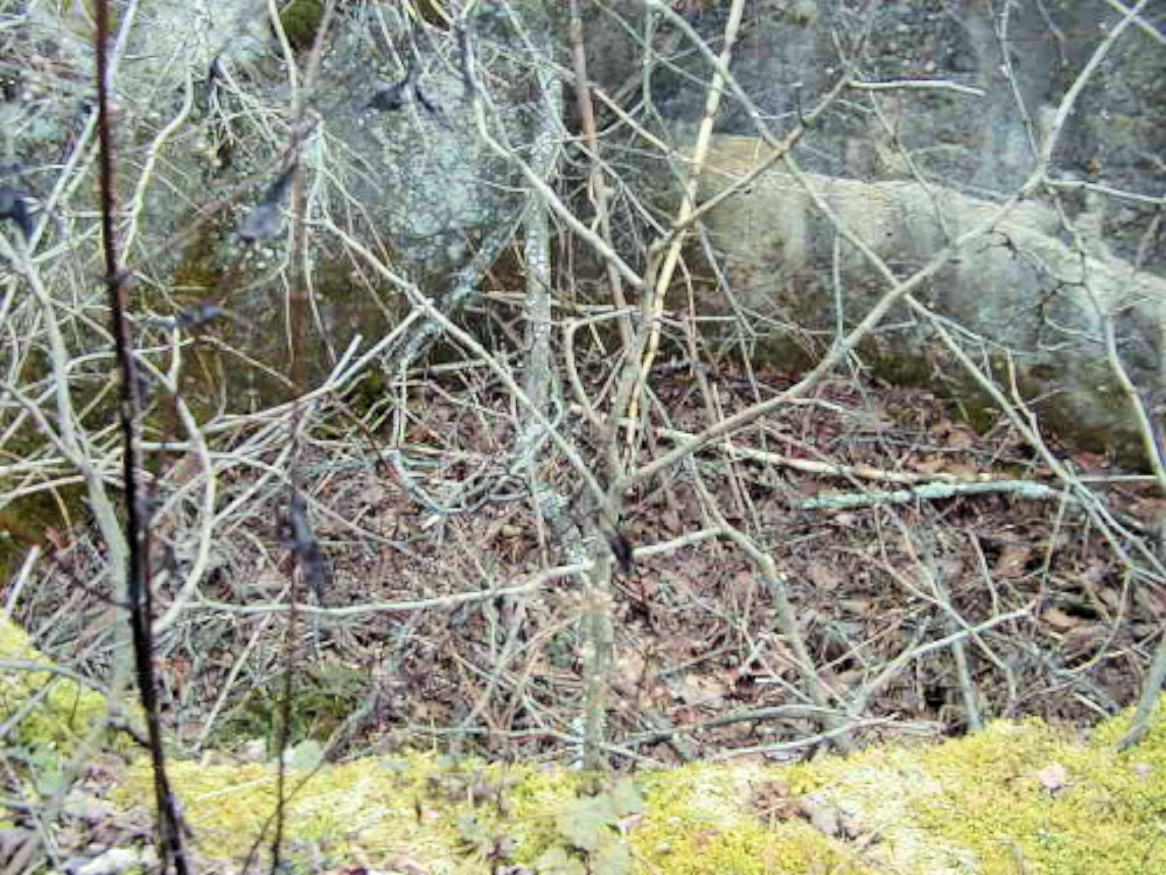
 View looking down nearly 6 feet into the cistern on which the silo was built
View looking down nearly 6 feet into the cistern on which the silo was built
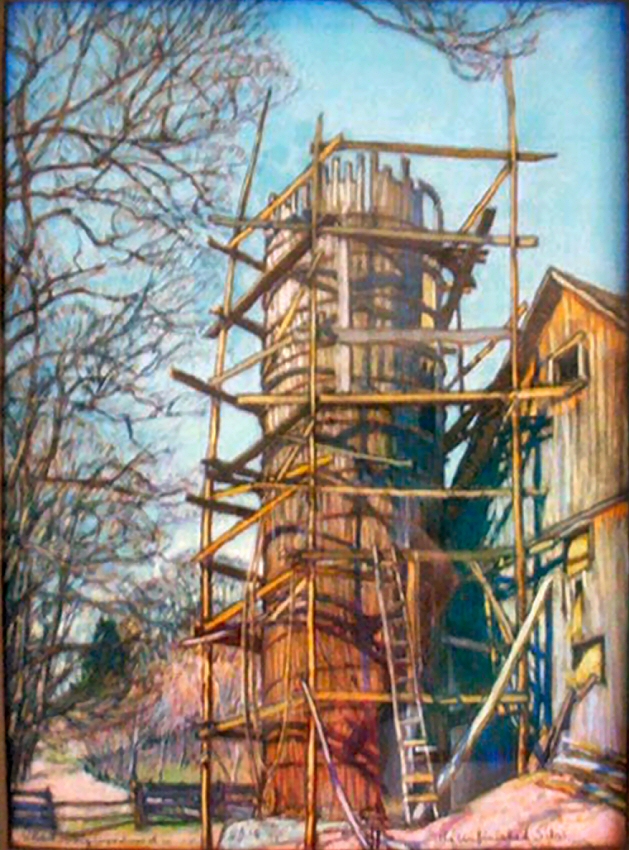
 The Unfinished Silo, chalk, 1929
The Unfinished Silo, chalk, 1929
Two chalks and one oil, all made around the same
year, 1929. The cistern is visible in each painting.
Change is difficult to accept. What was once an active working farm has now all but disappeared. I know it was my imagination but I swear I could smell the pungent odor of silage as I walked around the base of that old structure. Hopefully, the current owners of the two Woodwards will someday read this and travel down the Beldingville Road in Ashfield, MA, go past the Beldingville Cemetery, then down the steep hill to a spot just before a large close-to-the-road yellowish house, and stop to enjoy the spot at which their painting or chalk was made. It is likely that RSW drove in a buggy the 7 miles to this location with his beloved horse, Thomas à Kempis, from his first studio, Redgate, up East Buckland Road, on to Barnes Road, then left on Baptist Corner road and right onto Beldinville Road. Thomas à Kempis would be tied to a nearby tree during a day long painting session. Perhaps his trusted hired man accompanied him, although he would often make such a working trip by himself.
In trying to research the reason for a silo being built on top of a cistern reservoir rather than on a cement slab I spoke with an elderly farmer who said it was made to collect the liquid draining down from the fermenting corn piled into the silo above. This could be pumped out or siphoned out for a "good stiff one". This painting and this chalk drawing were made in the early 1930's. These were the days of prohibition. Remembering the odor of silage, I hate to think of the taste of the fermented brew at the bottom of a silo. But in those days people were desperate.
My own reminiscing on the Broadway musical The Music Man and the song "You've Got Trouble, My Friend." Part of the lyrics are: "When the cistern's empty on a Saturday night, you've got trouble my friend, trouble, trouble, trouble... right here in River City." I have concluded that this is was what Meredith Willson was probably thinking. Another person familiar with farm life told me that after a silo had fallen down the cistern was made into a swimming pool for the kids.
ADDENDUM: ITEM OF INTEREST:
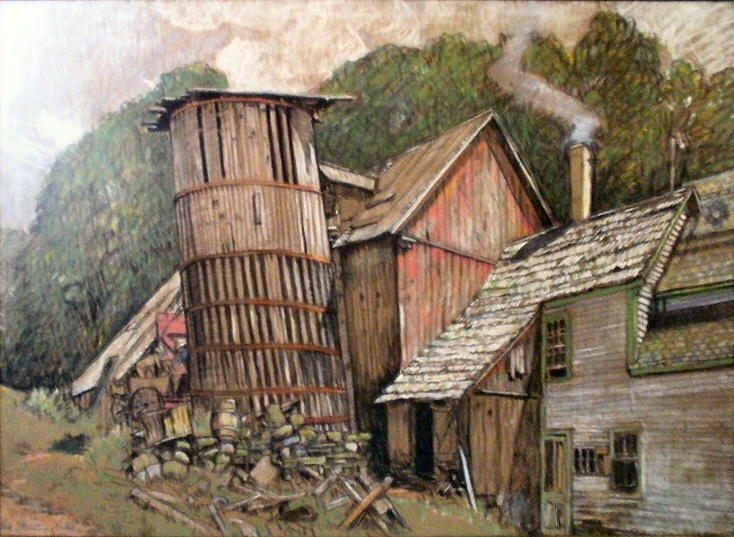
 The Slanting Silo, chalk, 1927-'28
The Slanting Silo, chalk, 1927-'28
Another silo painting from the same period of time. At
its foot, you see stacked stones surrounding the silo
supporting the concept that a cistern might be standard.
When visiting the site of The New Silo it was immediately obvious that the silo had been constructed on top
of a huge cement cistern. The rounded top of the large cement tub is visible in the original painting and in the chalk drawing. The pictures taken of
the site in November of 2006 show what this cistern looked like. These pictures also show the stone foundation which was under the side of the barn.
For days I was in wonderment as to why the silo was constructed in this way. When telling the story to a local farmer's son he said that this was a
way of collecting the results of fermentation (ie. ethyl alcohol for one) during the days of prohibition. All the juices resultant from the fermentation
process would be captured in the large cistern on which the silo was built. A hose could be dropped into this and the liquid either pumped or sucked
out, filtered and transferred to a wooden barrel. I could not find a living farmer today to confirm this ingenious use but it is probably true. I have since
considered the possibility that the collection tub was simply to collect all of the liquid resulting from the fermentation process and prevent it from
running out from the base of the silo onto the lawn. I prefer to believe the first explanation!
It has been a learning experience and a joy
to research the provenance on these two Woodwards. May the people who now own them enjoy them throughout their lives, and then pass them on
to their children for another generation of appreciation.
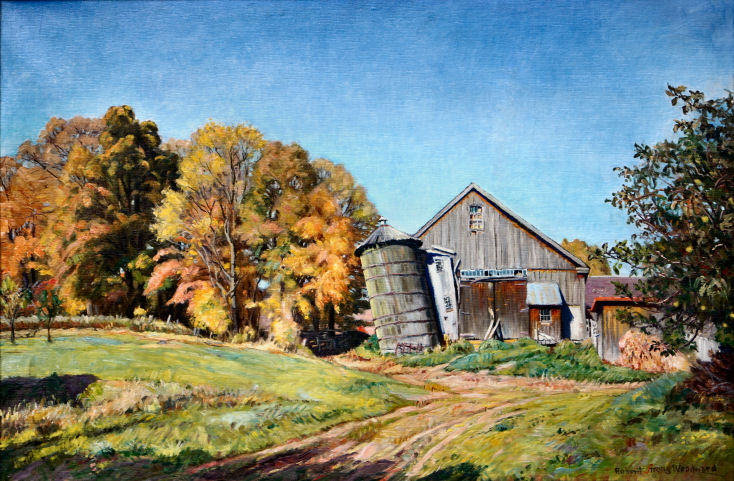
 The Slanting Silo, 1947. For all
The Slanting Silo, 1947. For all
of the barn Woodward painted in his career, there
are not that many with silos. This is one of his last.
ADDENDUM #2:
I received an e-mail from a "real farmer," one who has a working silo, and he presents a different view of the
need for a cistern:
 The silo was built on a cistern because silo 'juice' is highly acidic and corrosive. It needed to be collected so as to protect the surrounding environment
from being exposed to it.
The silo was built on a cistern because silo 'juice' is highly acidic and corrosive. It needed to be collected so as to protect the surrounding environment
from being exposed to it.
 It would terminate the life in a stream of trout or other waterway.
It would terminate the life in a stream of trout or other waterway.
 It would permanently contaminate a spring used for drinking water.
It would permanently contaminate a spring used for drinking water.
 It would damage any farm equipment that came into contact with it.
It would damage any farm equipment that came into contact with it.
 It would kill any living plant, tree, garden, etc.
It would kill any living plant, tree, garden, etc.
Corn was harvested early in the fall season (or late summer). Un-dried corn had a very high moisture content, causing the 'juice' to be prolific.
MLP, January, 2006
_____________________________________________________________________________________________
OCTOBER 2023

 July 2019: The Whole Team
July 2019: The Whole Team
L to R, First Row: Barbara and Mark Purinton
L to R, Second Row: Janet Gerry and Laurel Purinton Kerns
L to R, Third Row: Larch Purinton and Walter Kerns
L to R, Fourth Row: Peter Weidt and Brian Miller
We do not have much more to add or correct regarding Dr. Mark's essay. He was eighty years old when he went out there and did all that leg work with his wife Barbara. He started the website just 4 years earlier after he retired as the local country doctor. He was a remarkable man and we miss him dearly. ❤
There are some questions regarding Doc's reminiscence of the lyrics to one of the songs from the musical, The Music Man.
There are references in the song, "Ya Got Trouble", to the decline starts in the second verse with:
"I say, first, medicinal wine from a teaspoon,
Then beer from a bottle.
An' the next thing ya know,
Your son is playin' for money
In a pinch-back suit."
...and leads up to the cistern at the end of the third verse. But by that point in the song the degradation has progressed to the neglect of
the children's chores which can indicate that the cistern is empty because there is no corn in the silos. Whatever the case, the implication
is work is not getting done and it is also possible that whatever was left in the cistern before the work was not being done is now gone too.
Both can be true.
